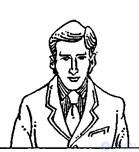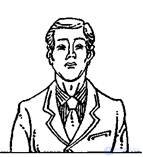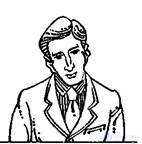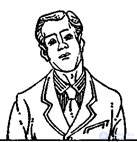Lecture
The goal of this lesson is to teach how to determine the kinema of the head in different situations, to interpret the information received and, accordingly, to plan communication. The lesson contains a lesson-training "Identify the head", exercises for the head and shoulders.
Panasyuk A.Yu. And what is he in the subconscious? (12 lessons on psychotechnology penetration into the interlocutor of the interlocutor). - M .: Delo, 1999. - 272
As we have already seen more than once, our subconsciousness fixes in the behavior of a partner even such moments that escape our consciousness. But the subconscious not only fixes what is not “hooked” in the consciousness, but also evaluates: this is good for my host or this is bad (dangerous, unpleasant).
In this section we will talk about the position of the head. In most cases, the position of the head is not controlled and reflects the interlocutor's position on the conversation, on the surrounding situation.
When analyzing the position of the head of the interlocutor, we will consider two aspects: the head tilts and head turns .
Let's start with the interpretation and explanation of the four variants of the head tilts.
1. "The head of the aggressor"

Figure 36
This position of the head, which you can find in your interlocutor, is characterized by the following: the chin is close to the chest (not necessarily close), and the look comes from under the eyebrows (figure 36). Why did this position of the head get such a name - “head of the aggressor”?
Remember the pose of a boxer - this is the “pose of a fighter”, the pose of a person who is going to either attack (show aggression), or, attacking, defend (show defensive aggression). We note a similar position of the head in an angry visitor, in a disgruntled subordinate chief, in boys ready for a fight, and in general for people ready for defense or attack. So the name “head of the aggressor” answers quite fairly, in full accordance with what we observe in everyday practice. But no less important is the answer to the following question: why so? Why when a person is dissatisfied with something, when he is going to show aggression, then his head takes the position of his chin - to his chest, and his gaze - from under his eyebrows. And the essence of the explanation lies in the psychology of our distant ancestors.
The concept of "beauty of the human body" came from the desirability of survival, self-preservation. The element of masculinity was a massive jaw, which was necessary for our male ancestors, not only to tear apart pieces of meat, but also for protection. On the body of a person there is one vulnerable place, when a person can be deprived of life simply by hand without any weapon. This is the laryngeal region, the breathing tube, which is covered in front only by weak cartilaginous rings. This explains the desire of a person to cover this vulnerable place, when even a not completely differentiated danger threatens. If the danger is real, i.e. someone is going to attack a person, or he is going to attack someone, then he quite instinctively covers this vulnerable place with his lower jaw.
If your partner, when communicating with you (quite instinctively), covers his vulnerable place with the lower jaw - the larynx, then at least he is in a state of defensive aggression, and how - maximum - he is ready to attack you. It does not matter if his aggression is only verbal, such as: “I declare to you a stern reprimand!”, “Your project undermines the foundations of our company, and we strongly protest! ..”, “Then I quit, and you stay what you want!” "I hate you!" Etc. It is important that this kinetic sign allows us to make a diagnosis before the negative attitude of our partner is verbalized in the form of the above phrases and to work out the correct attitude in the form of a positive attitude.
A variation of this kinema "The head of the culprit", but differs in the direction of the eyes.
2. "The head of the Lord"

Figure 37.
For a given position of the head (Figure 37) it is characteristic: the head is straight back, and the look is as if from top to bottom (this impression creates an angle between the direction of the look and the frontal plane of the face). Usually, having seen such a person, they say: “turned up his nose”, “looks down”, “self-satisfied”, “impudent look”, “with great self-conceit”, etc. It is obvious that all such reactions to this kinetic sign are negative.
But why such people, with such traits of character, when communicating with other people, throw their heads back? Why are they doing that?
Pay attention: the owner of this head, talking to us, not only does not protect his vulnerable place (larynx), not only opens this place, but even demonstrates it. And when a person can afford to show others their vulnerabilities? It is clear: when not afraid that someone will take advantage of this. And when is not afraid? When self-confident! When he won and - already lord of the situation! “The head of the sovereign” is characteristic not for those dictators who constantly fight with someone, fight to subjugate others, but for those who are already confident of their superiority over others - for the sovereigns!
If you have noticed that only when talking with you the head of your partner turns into a position - make a not very comforting conclusion for yourself: he strives for superiority over you. But a blessing in disguise: the position of his head allowed you to work out a strategy of behavior in advance: minimize contradictions during a conversation, say “yes” more often than “but”, and even better use the yes-but technique; not to demonstrate their superiority over him in any area; emphasize its real merits. Let him feel: you know and areas of his superiority over others, and the boundaries of this superiority. And then, on the one hand, he will be pleased to realize that you really appreciate his superiority over you, and on the other hand, your knowledge of these boundaries will soberate him somewhat, but it will not cause a clear negative reaction. And it is quite possible that in a few meetings with you this “head of the sovereign” will turn into a “head of the attentive”, which, as we know, causes a pleasant feeling in most people.
The “head of the sovereign” should be distinguished from the “head of the vanquished”, from whom she too can be thrown back, but her eyes will indicate something else.
3. "The head of the attendee"

Figure 38.
This is the very position of the head (Figure 38), which the perceiver at an unconscious level assesses as positive, pleasant.
"The head of the attentive" is characterized by a slope to the side (usually to the right, but this is not important) and slightly forward (down). What is this head talking about? "Side" - this position of the head is usually the one who listens, who wants to hear. And it happens when we are told either something interesting or something important, in general, that we would not like to “skip past the ears.” Question: Do you enjoy listening to your words? Well, who will say no! Of course yes. And then - see how he listens to us! And the head, pushed slightly forward and slightly down, is like a sign of respect: “I respect you!” Thus, the head of the attentive as if says: I am interested in your words, and I respect you personally.
Now imagine: there are two candidates on the television discussion. In two or three minutes of observing them, you noted that the first one always had “the head of the aggressor,” and the second had the same constantly “head that listened.” Consequently, at the subconscious level, the first causes involuntary alertness, an unconscious sense of tension in the speaker's perception (and this is already a “minus-reaction”), and the second is an involuntary positive attitude (“plus-response”). And then suppose that the first one expresses an idea that appeals to you, and it’s hard for you to agree with the second program, you don’t like it. And then you have an internal conflict: the first causes a "minus response" in the subconscious mind, but in the consciousness it causes a "plus reaction", and the second in the subconscious causes a "plus reaction", and in the consciousness - a "minus reaction". Who will win? Who do we go for, the first or the second? And it all depends on what is stronger - our subconscious or our consciousness and often our subconscious takes precedence over our consciousness!
Probably, it can be argued that with equal "power" of the subconscious and the conscious, the subconscious wins, because for him, the interests of the individual (the biological essence of man) is more important than the interests of the individual, because if a person dies, it does not mean that the individual will die, but if the individual dies, then the person will certainly also die. Such is the nature of this unique creation - man.
4. "The head of the president"

Figure 39.
In relation to this position of the head (Figure 39) of your interlocutor, the word “president” should be understood figuratively, i.e. as denoting a very high-ranking official who combines self-esteem with attention to others. The head, thrown back, demonstrates superiority over others, and at the same time inclined to one side - attention to others. Such a head as if says: I, of course, listen to you carefully, but you still do not forget who I am! And if during a business conversation you notice that your partner has “the head of the president”, you can be sure that this person knows his own worth, and he is not one of those who are approved at the expense of others. And most likely, it will not be wasted on trifles. For him, the essence of the matter is important, and for this he is ready to listen to you carefully. And if it comes to the conclusion that your idea deserves action, it will be ready to help you. But - at a distance. And by this the "head of the president" is different from the "head of the heed".
The “alien head” is similar in position to the “head of the president”, but it demonstrates indifference, aloofness, and therefore the look will be “eloquent”.
And now we turn to the analysis of turns of the head.
“He didn’t even turn his head” - “negative reaction”. Obviously, not very interesting. More interesting is another thing: what is the ratio of body rotation with head rotation? When the body and head have the same directionality, everything is clear, the value of each kinetic sign is amplified by another. Well, if their meaning is the opposite? Then try to answer: which of the two officials is more negative towards the visitor: the one with the body from the visitor - “minus-reaction”, and the head to the visitor - “plus-reaction”, or the one with the body - “plus-reaction ", The head -" negative reaction "? •
When we say that the “head” is turned towards the interlocutor, we mean not the “head”, but the face — the front surface of the head. And the “direction” of a person is the direction of a person. Consequently, the face, the head is closer to the personality than, say, the body. Hence the decision of the question - to trust more that which is closer to the person, i.e. to the psyche, the mental state of the partner.
And in conclusion of this section is a lesson-training.
1. Which of the 4 positions of the interlocutor's head causes a pleasant feeling in most people?
a) "The head of the aggressor."
b) "The head of the president."
c) "The head of the attendee."
d) "The head of the Lord" (select one answer).
2. Some say that they would usually like to see the head of the aggressor with the interlocutor. Who are they, who would suit it more?
a) Those who have a similar position of the head often, i.e. characteristic of themselves.
b) Those who have a similar head position are rare, i.e. uncharacteristically for them.
c) It has nothing to do with the most characteristic position of the head for themselves (select one answer).
3. If you make a list of the provisions of the head on the principle of reducing the negativism caused by the interlocutor, then which list is more consistent with this principle?
a) "Head of the aggressor", b) "Head of the aggressor",
"head of the president", "head of the ruler",
"the head of the lord," "the head of the attendee,"
"the head of the hearer". "head of the president".
c) "The head of the aggressor", d) "The head of the president",
"head of the lord", "head of the aggressor",
"head of the president" "head of the ruler",
"the head of the hearer". "the head of the hearer".
(select one list).
4. What is the difference between the “head of the aggressor” and the “head of the culprit”?
a) The position of the head relative to the chest.
b) The position of the chin.
c) Direction of sight.
d) Nothing (choose one answer).
5. When we see the “head of the aggressor” at the interlocutor, then its negative perception in most people is more likely to occur:
a) quite consciously;
b) at the subconscious level;
c) usually occurs in humans and so and so
(select one answer).
6. In what cases is a person ready to demonstrate to others his most vulnerable place on the body?
a) When I am sure that I am stronger than them.
b) When they fully recognize their power over themselves ("I give up!").
c) When he considers them his friends.
d) When he considers them his enemies
(exclude the wrong answer).
7. Why does the boxer's stand include the chin pressed to the chest?
a) Most likely, this is a kind of "mental impact" - in advance to intimidate your opponent.
b) Most likely, it protects the vulnerable spot in this way - the larynx.
c) Most likely, it reduces the area of the face.
(choose the most correct answer).
8. Why is a man's small chin perceived negatively?
a) Because most people consider it ugly.
b) Because it is appropriate.
c) Because it is difficult to cover the larynx with a small chin.
d) Because it indicates weak teeth.
d) Because it testifies of lack of will
(choose the most accurate answer).
9. "The head of the sovereign" is more likely to be combined with the phrase (sincerely, without implication):
a) "Your project is very interesting."
b) "I despise such people."
c) "Then let's think together about how to solve ..."
d) "Now I will teach you how! .."
d) "Sorry, please, I will no longer"
(select one answer).
10. What does the head of the president say?
a) About attention to people.
b) About self-esteem.
c) Simultaneously "a" and "b".
d) About his superiority over people.
e) About conflict character.
f) Negative attitude towards people (choose one answer).
11. "The head of the president" is the name given to this position of the head by the author in honor of one real president, for whom this position of the head is very characteristic.
This is typical for:
a) the former president of the USSR M. Gorbachev;
b) the former president of Georgia 3. Gamsakhurdia;
c) the former president of Ukraine L. Kravchuk;
d) the former president of Chechnya D. Dudayev
(select one answer).
12. If the interlocutor says something to you, and his head is not turned towards you, this means:
a) he doesn’t really care how you take it all;
b) what he says he does not consider important;
c) he has a negative attitude towards you;
d) he hides (intentionally, consciously) his sympathy for you;
e) under all circumstances this is a plus-reaction.
(exclude the wrong hypothesis).
13. Landing your interlocutor: the body - to you, and the head - a little to the side, glance as it were. For you it is rather:
a) does not mean anything;
b) more "plus" than "minus";
c) more "minus" than "plus";
d) either "plus" or "minus" - depending on other signs. (select one answer).
14. The head of your interlocutor is turned to you, but the body is slightly to the side. For you it is rather:
a) does not mean anything;
b) more "plus" than "minus";
c) more "minus" than "plus";
d) either "plus" or "minus" - depending on other signs
(select one answer).
15. “Alien Head” refers to:
a) aggressiveness;
b) care;
c) about anything ("does not want" to speak);
d) benevolence (choose one answer).
Davies F. Your absolute image. A book for politicians and businessmen, men and women. M .: - Vneshsigma, 1997. - 302s.
Exercises for the head, neck and shoulders.
Your head and neck.
When communicating with others, we usually look at each other’s neck and head. The back of the neck is one of the most common areas of stress. If someone annoys you, you literally feel pain in your neck. Very often, when a person is tired or tense, he raises his hand and massages the back of his neck, thereby showing where he has tension, even if he does so unconsciously.
If this particular part of your body is tense, you will constantly talk while pulling your chin forward. This habit shortens the neck visually, since the head is drawn into the body. Or you bow your head to the side, which gives you a questioning look and completely deprives your appearance of determination and strength. If you often put your head down to your chest, you will transmit signals of shyness, a desire to remain in the shadows or even fear. These habits are even more noticeable when you talk to others and feel that you are being “watched”, for example, at a lively party. , speaking at a meeting or meeting someone for the first time.
Try to look at yourself in the mirror objectively or ask a friend or relative to help you. The spine always has a bend in the neck. Find out what your automatic response is: pull your head forward or raise your chin — many of us react this way every time we talk to others or make some effort.
If your head is comfortable in a central position, if it is its natural position, then you will not have tension in the neck or throat and this will benefit your overall image,
Exercise 1. To relieve tension from the neck.
1. Smoothly leave your head like those toy dogs that are placed near the rear window of the car. Your task is to stretch the neck muscles and ease the tension. Установив плавное, почти гипнотическое движение головы и почувствовав, что шея расслабилась, походите по комнате, все еще плавно покачивая головой. Многие люди во время ходьбы выдвигают голову вперед, как бы идут следом за головой, в результате создается напряжение. Это упражнение способствует устранению этой привычки.
2. Помассируйте шею со спины круговыми движениями вдоль двух больших мышц, идущих от верхней части спины до затылка. Если мышцы твердые, значит они напряжены. После массажа они должны стать мягче.
3. Плавно повращайте головой, при этом лицо должно быть направлено вперед, не надо его поворачивать из стороны в сторону, Ваша цель - растянуть и расслабить мышцы шеи, а не выкручивать их. Смените направление вращения.
4. Опустите голову на грудь. Помните, что средняя голова весит около четырех килограммов. Сцепите пальцы рук и положите их на затылок; это поможет лучше растянуть шею. Отрегулируйте положение шеи и плеч, так чтобы чувствовать себя удобно в этом положении, и медленно выдохните воздух.
Ваши плечи
Некоторые из нас выглядят так, как будто «несут весь мир» на своих плечах. Шея и плечи тесно связаны друг с другом, поэтому если один из этих участков напряжен, то напряжение распространится и на другой участок. Если у вас напряжена задняя часть шеи, образуя очень большой изгиб в верхней части позвоночника, то плечи ваши начнут округляться. Плечи являются относительно большим участком тела, и напряжение от них может быстро перейти на руки, кисти рук и пальцы. Поэтому многие из нас совершенно не могут стоять, опустив расслабленно руки: мы барабаним пальцами по бедрам и сжимаем кулаки.
The shoulders are the main stretch of tension for many people, and when they are strained they look slightly raised and moved forward. If you have such a shoulder position, tell yourself at every opportunity: “lower your shoulders and take them back,” especially when you are sitting on a train, walking down the street or driving a car. This will help relieve stress. Try to reinforce such a reaction, turning it into a habit. Shoulders play an important role in shaping impressions, so overhead shoulders give people a more domineering look. If you want, the shoulders are the hanger on which the rest of the body hangs. Look at people who are on television (especially those who talk about a crisis or who ask cross-questions), and you will learn to recognize the tension of the shoulders. The following are exercises for relieving tension from the shoulders and chest.
Упражнение 2. Ддля снятия напряжения с плеч и груди
1. Поднимите плечи и опустите их, полностью расслабив. Поднимите их постепенно к ушам, попеременно двигая каждое плечо. Опустите плечи.
2. Плавно отведите плечи назад, растягивая при этом мышцы груди, затем сдвиньте их вперед, растягивая лопатки. Выполните упражнение пять раз вперед и пять раз назад. В промежутках между упражнениями проверяйте, не образовалось ли напряжение в области шеи, для чего кивните несколько раз головой.
3. Поднимите прямые руки вперед перед грудью и сцепите пальцы рук. Не поднимая плеч, вытяните руки вперед и снимите напряжение с лопаток.
4. Сцепите пальцы рук за спиной и потяните руки вверх, отводя их одновременно от корпуса. Вы должны почувствовать, что это упражнение снимает напряжение с груди и лопаток.
5. Люди, у которых очень напряжена грудь, выглядят слегка надутыми (напыщенными). Из-за этой манеры держаться им приписывают большое самомнение. Типичная для них реакция во время паники - положить руку на грудь, как бы пытаясь успокоить себя. Выгните позвоночник, втянув грудь, затем разогнитесь, отведя плечи назад, одновременно опуская их вниз. Снятие напряжения с мышц груди поможет вам выработать правильную осанку.
Comments
To leave a comment
Kinesika
Terms: Kinesika